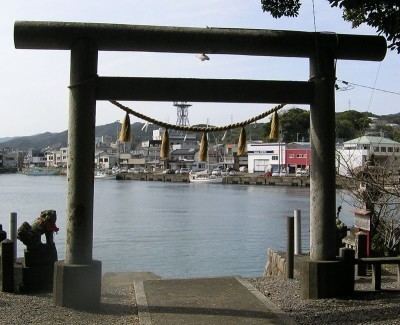Country Japan Population 14,666 (31 Jan 2016) Local time Monday 11:21 PM | ||
 | ||
Time zone Japan Standard Time (UTC+9) Website www.city.tosashimizu.kochi.jp Weather 13°C, Wind NW at 11 km/h, 67% Humidity City hall address 11-2 Tenjinmachi, Tosashimizu-shi, Kōchi-ken; 787-0392 | ||
Tosashimizu (土佐清水市, Tosashimizu-shi) is a city located in the southwest of Kōchi Prefecture, Japan. The city was founded on August 1, 1954. As of 31 January 2016, the city has an estimated population of 14,666, with 7,608 households and a population density of 55.02 persons per km². The total area is 266.54 km².
Contents
- Map of Tosashimizu Kochi Prefecture Japan
- Industry
- Roadside stations
- Cape Ashizuri
- Birthplace of Nakahama Manjir
- Wildlife tours
- Whale shark swim
- Ocean sunfish swim
- Whale watching
- The Shikoku Pilgrimage
- Rail
- Sister cities
- References
Map of Tosashimizu, Kochi Prefecture, Japan
Of the 11 cities in Kochi Prefecture, Tosashimizu has the second lowest population which was over 30,000 in 1954 compared to 14,937 as of March 31, 2015.
It is the only city on Shikoku island which hosts an Air Self-Defense Force (ASDF) base.
Industry
The largest industry is fishing, especially deep-sea fishing. Sōdabushi, locally called mejikabushi, is one of the main seafood produce in the area with a market share of approximately 70%. It uses sōdagatsuo (frigate mackerel) and is manufactured using a similar process to katsuobushi. The local fishermen's union registered their catch of blue mackerel Scomber australasicus as "Tosano shimizusaba", or blue mackerel of Shimizu, Tosa.
Osaka Aquarium Kaiyukan has a branch in Tosashimizu, and Osaka Aquarium Biological Research Institute of Iburi Center (OBIC) provides one third of those marine animals displayed at the aquarium in Osaka. The Center conducts scientific studies at its facility including a 1,600 ton tank.
Roadside stations
Mejikano sato Tosashimizu roadside station is near scenic Tatsukushi along route 321. Mejika means sōdagatsuo (frigate mackerel) in the local dialect, and they manufacture and sell sōdabushi, the main sea food produce of the city, processed for demonstration at the factory at the back of the store for direct selling. Farm produce is also sold at this roadside station.
Cape Ashizuri
The 70 km coastline stretching from the northeast to southwest boundaries of Tosashimizu attracts over 800,000 tourists to Tosashimizu each year. Ashizuri-Uwakai National Park includes Ashizuri, the largest peninsula in the area. Tosashimizu is the nearest city to Ashizuri peninsula which is protruding into the Pacific ocean. Cape Ashizuri is 80 meters above sea level at the southeastern end on the peninsula. The peninsula is covered by subtropical plants including camellia, holm oak, and colony of Livistona Livistona chinensis, and the sea is a prime fishing ground for katsuo fish, or skipjack tuna Katsuwonus pelamis. While there are small islands to the south of it, the cape is recognized as the southern most location on Shikoku island at 32°43′24″N 133°1′12″W.
Tatsukushi geologic strata with layers of sandstone and mudstone form joints and layers. A gate-like rock on the coast, Hakusandōmon is on the west side of the cape. Tōjindaba Site is a prehistoric megalithic site with stone circle, located on the west hill on Cape Ashizuri.
Birthplace of Nakahama Manjirō
On the western shore of Ashizuri peninsula, lies the village of Nakanohama within Tosashimizu, where Nakahama Manjirō was born and became the first Japanese person to travel to the United States. Manjirō, a young fisherman, was shipwrecked off the coast of Japan in 1841 and rescued by whaling captain William Whitfield of Fairhaven, Massachusetts. Whitfield brought the young Manjirō back to Fairhaven and New Bedford at the end of the whaling voyage, and Manjirō spent several years there before eventually making his way back to Japan. Because of this history, Tosashimizu became the sister city of both Fairhaven and New Bedford in 1987. He became popular as John Manjirō after Ibuse Masuji depicted him in his novel John Manjiro. The Castaway: His Life and His Adventures.
Wildlife tours
There are several wildlife tours popular on Ashizuri peninsula; wildlife swims are organized in the town of Iburi on the foot of Ashizuri peninsula.
Whale shark swim
Whale sharks migrate off the Ashizuri Peninsula between June and September, and some are kept captive in a cage 300 m offshore.
Ocean sunfish swim
Between April and the end of July each year, ocean sunfish are kept in a net cage 10 m by 10 m and 5 m deep. When the water temperature rises, they release the fish into the wild.
Whale watching
Whale watching is also offered on the east side of the peninsula, based at Kubotsu town to the middle and Shimonokae to the north.
The Shikoku Pilgrimage
The Shikoku Pilgrimage passes through the city, and the longest stretch of 80.7 km on the route is between the 37th temple (Iwamoto-ji (岩本寺)) in Shimanto and the 38th temple (Kongōfuku-ji (金剛福寺)) on Cape Ashizuri. Descending from Itsuta pass (伊豆田峠) toward Tosashimizu, there is Shinnenan (真念庵), a small wayside hermitage 28 km from Kongōfuku-ji. It was designated to provide a free lodging for pilgrims on that section, where people could also leave their luggage while visiting Kongōfuku-ji, come back to Shinnenan and continue on to the 39th Enkō-ji in Sukumo 50.8 km away.
Rail
The nearest train station is Nakamura Station, the terminus of the Tosa Kuroshio Railway Nakamura Line, located in Shimanto. A bus service connects Tosashimizu with Nakamura Station, taking approximately 60 minutes.
